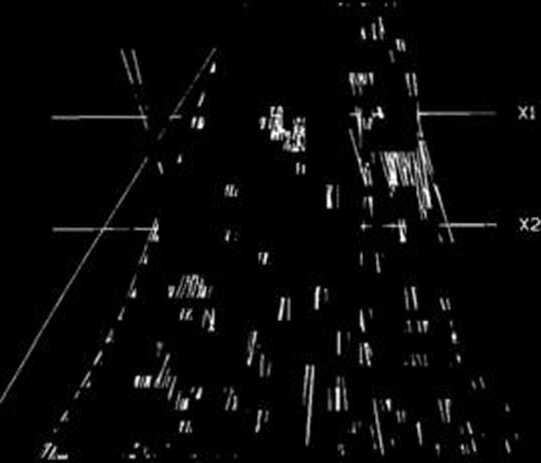372596145
108
RIKEN Accel. Próg. Rep. 24 (1990)
111-5-12. Status Report of the RIKEN Swinger-Magnetic Analyzer with Rotators and Twisters (SMART)
H. Ohnuma, Y. Fuchi, K. Hatanaka, S. Hayakawa, T. Ichihara, M. Ishihara, M. Kasę, S. Kato, T. Kubo, S. Kubono, M. Ohura, H. Okamura,
H. Orihara, H. Sakai, H. Shimizu, Y. Tajima, M.H. Tanaka,
H. Toyokawa, Y. Yano, Y. Yashiro, H.Y. Yoshida and M. Yosoi
A swinger and a magnetic analyzer with rotators and twisters (SMART) have been installed in the experimental area E4 and are currently tested with beams from RRC.
The magnetic analyzer consists of three quad-rupoles and two dipoles (PQ1-PQ2-PD1-PQ3-PD2), as described in previous reports,l) and the swinger has two dipoles and two quadrupoles (WD1-WQ1-WQ2-WD2). Results of the field measurements of these magnets, carried out in February and March this year, are described in a separate report.2)
A target chamber and other vacuum chambers were installed in May. The entrance window of the target chamber has sliding membranę which moves together with the beam swinger when the incident beam direction is changed. Three sets of defining slits of the spectrometer can be inserted behind the target chamber. The vacuum chambers are designed in such a way as to facilitate smali angle (including 0°) measurements. Several beam-stoppers are prepared for this purpose, one attached to the target chamber, one between PQ1 and PQ2, two inside the PI)1 vacuum chamber, and one at the exit of PD1. After wiring control cables, they have been tested for vacuum and mechanical movements.
The first beam was led through the twister and the swinger onto a target in June 24, 1990. A 135 MeV 14N beam was successfully transported giving a spot size of about 3 mm in diameter on a target.
Further tests of the system were carried out in July and August using a 140 MeV deuteron beam. Achromatic modę of the beam transport was used, and the alignment of the beam axis was checked using several beam-profile monitors along the beam linę and two scintillator targets, one at the target position and the other at the 0° exit of the PD1 vac-uum chamber. The beam spot was found to remain unchanged, as expected from optics calculations, when the swinger was rotated along with
the twister.
After beam alignment, a faint beam was brought down to the first and the second focal planes to test the performance of the focal piane detectors. Scat-tered deuterons were also observed with the focal piane detectors. Figurę 1 shows a reproduction of rays traced with single-wire proportional counters in the second focal piane. A thick bundle of rays represents deuterons elastically scattered from a 20 /xm thick gold target. The overall energy resolution was about 1/1,000 after correcting for abberations, almost equal to the energy resolution of the beam in the achromatic modę. In addition, neutron time-of-flight spectra were taken with a 8.6-m flight path as reported elsewhere.*0 Further tests of the system are under way.

Fig. 1. Rays of deuterons reproduced from raw data obtained with SWPC in the second focal piane. A thick bundle of rays corresponds to deuterons elastically scattered from a 20 /xm thick gold target.
References
1) H. Ohnuma et al.: RIKEN Accel. Próg. Rep., 21, 164 (1987); 22, 148 (1988).
2) Y. Tajima et al.: This Report, p. 109.
3) M. Orihara et al.: This Report, p. 121.
Wyszukiwarka
Podobne podstrony:
74 RIKEN Accel. Próg. Rep. 24 (1990)111*3-10. A Multitracer Study of the Adsorption of Metal Element
105 RIKEN Accel. Próg. Rep. 24 (1990)111-5-10. Velocity Distribution of IGISOL lon Beams M. Koizumi,
12 RIKEN Accel. Próg. Rep. 24 (1990)111-1-3. Coulomb Breakup Reaction of 90 MeV/u 140 T. Takei, T. M
12 RIKEN Accel. Próg. Rep. 24 (1990)111-1-3. Coulomb Breakup Reaction of 90 MeV/u 140 T. Takei, T. M
109 R1KEN Accel Próg. Rep. 24 (1990)IH-5-13. Field Measurements of the SMART Magnets Y. Tajima, K. H
92 RIKEN Accel. Próg. Rep. 24 (1990)111-5. Instrumentation1. Design of a Microbeamline for a Compact
94 RIKEN Accel. Próg. Rep. 24 (1990)111-5-2. Design of a Decay Muon Channel Using an Axially Symmetr
102 RIKEN Accel Próg. Rep. 24 (1990)111-5-8. Performance of Isotopic Separation in RIPS T.Nakamura,
103 RIKEN Accel. Próg. Rep. 24 (1990)111-5-9. Test Experiment of the GARIS/IGISOL K. Morita, T. Nomu
110 RIKEN Accel. Próg. Rep. 24 (1990)111-5-14. Test for Dispersive-Mode Beam Transportto the SMART
116 RIKEN Accel. Próg. Rep. 24 (1990)111-5-19. Responses of Large Position-Sensitive Detectorsto Hea
RIKEN Accel. Próg. Rep. 24 (1990)111-5-25. High Speed Serial Data Link for PC-9801 J. Fujita > PC
11 RIKEN Accel. Próg. Rep. 24 (1990)111-1-2. Three a Disintegration of 12C in the Field of208Pb Nucl
29 RIKEN Accel. Próg. Rep. 24 (1990)111-1-19. Dissociation Cross Sections of nLiK. Soutome, S. Yamaj
RIKEN Accel. Próg. Rep. 24 (1990)111-1-20. Induced Fission Studied with a Multi-DimensionalLangevin
więcej podobnych podstron